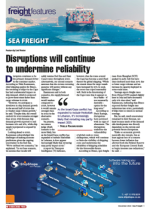As South Africa’s ports grapple with ongoing challenges and operational inefficiencies, technology-driven solutions are becoming increasingly vital. According to Leon Jansen, projects and development manager at ShipShape, these solutions not only enhance visibility and automate data f lows but allow companies to adapt to industry challenges.“There’s been a strong shift towards system integration across the supply chain, aimed at addressing the inefficiencies,” he told Freight News. “It is all about improving visibility, automating data f low, and enhancing data quality. For instance, our integrations with NVOCCs like Contra Consolidators and SACO Shipping are already yielding significant benefits.”One of ShipShape’s more recent innovations is its automated vessel tracking service, which is tightly integrated with its shipment management modules, client status reports and the WebTracker portal. This technology enables importers and exporters to monitor and track shipments in near real-time, significantly enhancing operational planning.“Our solution provides access to shipping line sailing schedules and automated updates on arrival and departure dates,” said Jansen. “This level of visibility is critical for navigating the complex logistics environment.”The South African freight and logistics sector faces significant challenges, particularly in port performance. The 2023 World Bank Container Port Performance Index (CPPI) ranked Cape Town last out of 405 ports, with Ngqura, Durban and Gqeberha also near the bottom. Chronic issues such as port congestion, outdated infrastructure, labour disputes and bureaucratic inefficiencies contribute to these poor rankings.“These challenges are not only delaying cargo handling and vessel turnaround times but are also increasing costs for businesses and impacting the overall supply chain efficiency,” said Jansen. “A direct side effect of the poor performance of our ports is the unpredictability of estimated times of arrival of vessels (ETAs). While shipping lines can estimate sailing times, the allocation of berthing slots by Transnet introduces significant variability.”Another emerging trend, said Jansen, was partial discharges. “This occurs when port authorities allow vessels waiting at anchorage outside the port to berth brief ly to unload high-value or perishable cargo and then reschedule for a later date to discharge the remaining containers. This adds complexity to scheduling and logistics operations.”ShipShape’s Vessel Tracking Control Tower is instrumental in mitigating these challenges. By working closely with international partners and port authorities, the company ensures that sailing schedules are continuously updated with the latest arrival and departure dates. LV

